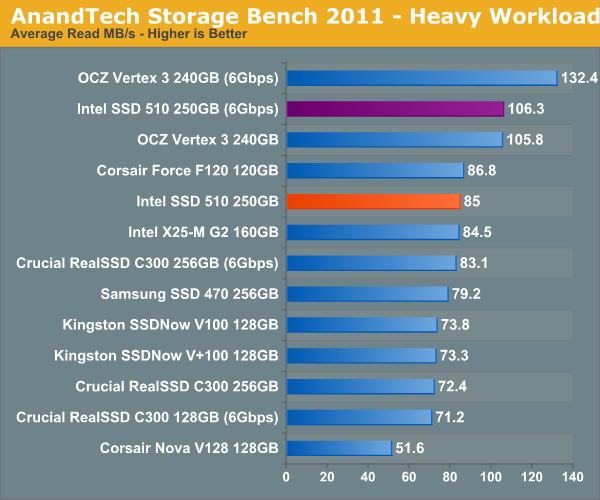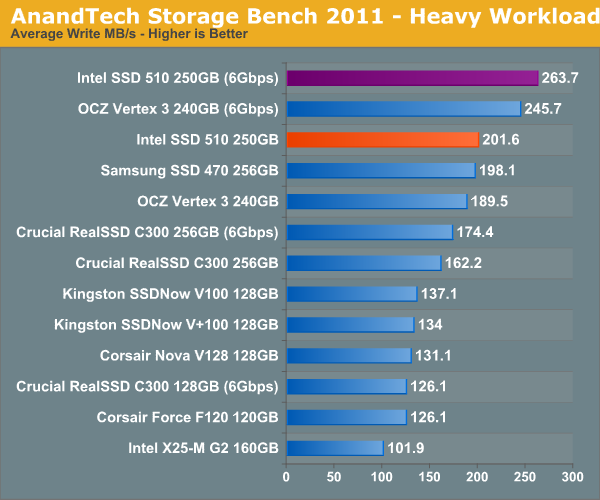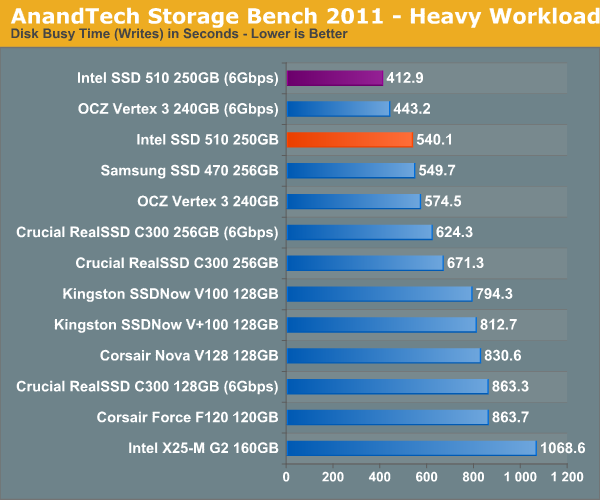The Intel SSD 510 Review
by Anand Lal Shimpi on March 2, 2011 1:23 AM EST- Posted in
- IT Computing
- Storage
- SSDs
- Intel
- Intel SSD 510
AnandTech Storage Bench 2011: Much Heavier
I didn't expect to have to debut this so soon, but I've been working on updated benchmarks for 2011. Last year we introduced our AnandTech Storage Bench, a suite of benchmarks that took traces of real OS/application usage and played them back in a repeatable manner. I assembled the traces myself out of frustration with the majority of what we have today in terms of SSD benchmarks.
Although the AnandTech Storage Bench tests did a good job of characterizing SSD performance, they weren't stressful enough. All of the tests performed less than 10GB of reads/writes and typically involved only 4GB of writes specifically. That's not even enough exceed the spare area on most SSDs. Most canned SSD benchmarks don't even come close to writing a single gigabyte of data, but that doesn't mean that simply writing 4GB is acceptable.
Originally I kept the benchmarks short enough that they wouldn't be a burden to run (~30 minutes) but long enough that they were representative of what a power user might do with their system.
Not too long ago I tweeted that I had created what I referred to as the Mother of All SSD Benchmarks (MOASB). Rather than only writing 4GB of data to the drive, this benchmark writes 106.32GB. It's the load you'd put on a drive after nearly two weeks of constant usage. And it takes a *long* time to run.
I'll be sharing the full details of the benchmark in some upcoming SSD articles but here are some details:
1) The MOASB, officially called AnandTech Storage Bench 2011 - Heavy Workload, mainly focuses on the times when your I/O activity is the highest. There is a lot of downloading and application installing that happens during the course of this test. My thinking was that it's during application installs, file copies, downloading and multitasking with all of this that you can really notice performance differences between drives.
2) I tried to cover as many bases as possible with the software I incorporated into this test. There's a lot of photo editing in Photoshop, HTML editing in Dreamweaver, web browsing, game playing/level loading (Starcraft II & WoW are both a part of the test) as well as general use stuff (application installing, virus scanning). I included a large amount of email downloading, document creation and editing as well. To top it all off I even use Visual Studio 2008 to build Chromium during the test.
Many of you have asked for a better way to really characterize performance. Simply looking at IOPS doesn't really say much. As a result I'm going to be presenting Storage Bench 2011 data in a slightly different way. We'll have performance represented as Average MB/s, with higher numbers being better. At the same time I'll be reporting how long the SSD was busy while running this test. These disk busy graphs will show you exactly how much time was shaved off by using a faster drive vs. a slower one during the course of this test. Finally, I will also break out performance into reads, writes and combined. The reason I do this is to help balance out the fact that this test is unusually write intensive, which can often hide the benefits of a drive with good read performance.
There's also a new light workload for 2011. This is a far more reasonable, typical every day use case benchmark. Lots of web browsing, photo editing (but with a greater focus on photo consumption), video playback as well as some application installs and gaming. This test isn't nearly as write intensive as the MOASB but it's still multiple times more write intensive than what we were running last year.
As always I don't believe that these two benchmarks alone are enough to characterize the performance of a drive, but hopefully along with the rest of our tests they will help provide a better idea.
The testbed for Storage Bench 2011 has changed as well. We're now using a Sandy Bridge platform with full 6Gbps support for these tests. All of the older tests are still run on our X58 platform.
AnandTech Storage Bench 2011 - Heavy Workload
We'll start out by looking at average data rate throughout our new heavy workload test:

There's simply no dethroning the Vertex 3, but Intel's SSD 510 does come dangerously close. Over a 6Gbps interface the 510 delivers 93% of the performance of the Vertex 3. Over a 3Gbps interface the gap narrows to a meager 5.2%.
The breakdown of reads vs. writes tells us more of what's going on:

The Vertex 3 is nearly 25% faster than the 510 if we just isolate the reads conducted by our benchmark. Remember the poor random read performance? I suspect that's at play here. The Intel SSD 510 on a 6Gbps interface is about the speed of the Vertex 3 on a 3Gbps port.

Ah ha! This is where the picture shifts. Our heavy workload does have a significant amount of incompressible writes which significantly reduce the performance of the Vertex 3. The V3 loses enough ground that the 510 is 7% faster in writes during our benchmark.
The next three charts just represent the same data, but in a different manner. Instead of looking at average data rate, we're looking at how long the disk was busy for during this entire test. Note that disk busy time excludes any and all idles, this is just how long the SSD was busy doing something:













128 Comments
View All Comments
Golgatha - Wednesday, March 2, 2011 - link
I'd also like to add that you will however most certainly notice the difference of 3.15MB/s of random R/W performance my RAID0 Velociraptors put out versus the random R/W performance of pretty much any SSD. SSDs make a huge amount of sense as an OS and applications drive.
EddyKilowatt - Wednesday, March 2, 2011 - link
"...the last thing SSDs are lacking is speed..."Amen. Ninety percent of us still have 3 GB SATA and are just waiting for the 25 nm devices to do their thing to the $/GB on more prosaic drives
mgl888 - Wednesday, March 2, 2011 - link
I had high expectations from Intel.. now I'm a little disappointed.As the article said, random read is MOST important for a boot drive. Surely Intel should know this?
critical_ - Wednesday, March 2, 2011 - link
I'm not sure I agree.1. The SSD market still has a lot of growth ahead of it. Price per GB is the current issue and may be the new "performance per watt" buzz word in this space. Case in point, when I can grab a cheap Dell server for $350 and average notebooks are advertised everyday for $300-$600, are people really going to spend $300-$600+ on an SSD? If it was a much cheaper option then many would go with it.
2. Synthetic vs. Real-world. Synthetic benchmarks are great for bragging on the various overclocking forums but most of us get work done in the real-world. This is no different than people who tune cars for 1/4 mile races but must transport the car on a flat-bed carrier. For some this is a perfectly great trade-off for bragging rights but many of us prefer to get 90% of the 1/4 mile performance and be able to drive the car back and forth to a weekend outing. My point is that in real-world benchmarks there may be some minor deficiencies but will 95% of users notice? I doubt it.
3. I put an Intel X-25M G2 160GB SSD in my father's quad-core desktop that he uses for Photoshop work after listening to many months of complaints that his system was too slow. After the swap, he loves the performance and I love the fact that I'm no longer fielding "it's too slow" complaints. This was the best money I've spent in recent memory but the price is still an issue for most people.
4. Would a user like my father noticed a difference between the X-25M and either a 510 or Vertex 3? I doubt it. Besides we'd have to get him a SATA3 motherboard or an add-in card. Again, it's a price issue.
5. Not too long ago the must-have upgrade was adding RAM to a Windows machine. These days 3-8GB systems are almost the norm so the must-have upgrade is an SSD if a user can stomach the cost. Head on over to NewEgg and read the reviews of "value" SSDs and you'll get an idea of the disappointment for some people who transitioned from HDDs to SSDs in both desktops and laptops. The drives in this segment aren't changing the user experience as dramatically as those ponying up for the high-end devices. Then there is the issue of lack of TRIM support, 4K issues, firmware upgrades destroying data, and the list goes on. The segment needs to addressed by Intel.
6. Finally, hybrids. We see the Intel Z68 will support SSD caching along with higher-end stuff from Adaptec or HighPoint's RocketHybrid controllers trying to get the best of both SSDs and HDDs. Could this be a game-changer? Possibly.
The points that I'm making come down to both real-world performance and market segments. The SSD market would benefit from a better stragety on the entry-level and mid-range markets the way ATI and nVidia have done things. Whoever brings the price down to grab the majority of users will eventually win a good chunk of business. With all that aside, as it stands the 510 is fine for the types of loads I'd put on an SSD as a power user so I'm happy to trade a bit of real-world performance for Intel's reliability.
landerf - Wednesday, March 2, 2011 - link
Well that was disappointing. Unless intel prices themselves under OCZ they may do very poorly with this drive.semo - Wednesday, March 2, 2011 - link
The sad thing is that they won't. They always have their "conroe" moment and then they sink up their product in the next generations but they still come out ahead. Even their Prescott cores did very well when they shouldn't have.vol7ron - Wednesday, March 2, 2011 - link
Yeah that was my fault. I shouldn't have bought a Prescottm.amitava - Wednesday, March 2, 2011 - link
I am really the biggest fan of Anand and his team (used to bypass my company firewall and risk losing my job just to read all the stuff here..) but it does seem like Anand is trying to smooth over the 510's seriously non-competitive random performance....IMO it showed badly enough that I finally decided to sign up and post a comment...
I hope I am mistaken...
Sigwulff - Wednesday, March 2, 2011 - link
Well isn't it the old debate regarding synthetic vs. real-world tests? I'll admit it looked bleak for the random parts, but looking at the heavy and light workload 510 looked somewhat shinier...I was 100% sure on the Vertex 3, but presently I'll have to wait and see about the pricing when it lands here in little Denmark :-)
Btw, mentioning the bundle you completely overlooked the very nice cabinet sticker Intel included. I would like some tests about glue adherency, how envious your friends look when they see the sticker on your pc-cabinet etc. :-)
ok just kidding, very nice and informative review! (why we love Anand so much :-)
semo - Wednesday, March 2, 2011 - link
+1I'm still disappointed that Anand hasn't covered the OCZ Vertex 2 "25nm version" con. This is a consumer rights issue and should take precedence over any other development of a technical nature.